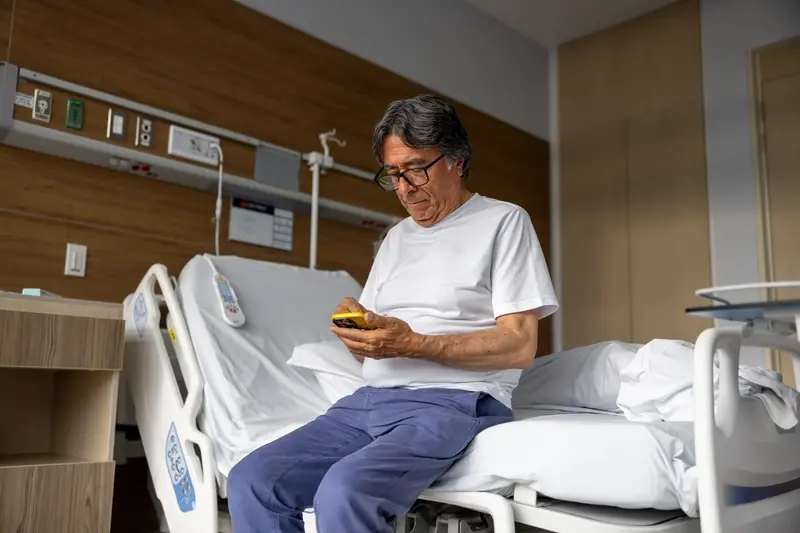What Makes Patients Trust A Medical App?
Trust is everything when it comes to healthcare apps. I've spent years building medical apps for various clients, and one thing has become crystal clear—patients won't use an app they don't trust. And who can blame them? They're sharing their most personal information: symptoms, medications, family history. That's not the sort of data you hand over lightly.
The challenge facing healthcare app developers today is bigger than just creating something that works. We need to build something that feels safe, reliable, and professional. Patients aren't just downloading another social media app here—they're potentially putting their health in our hands. That comes with massive responsibility.
When patients trust your app, they engage more deeply with their healthcare, leading to better outcomes for everyone involved
Throughout this guide, we'll explore what makes patients feel confident about using medical apps. From security features that actually work to designs that don't make people feel lost, every element plays a part. Patient app behaviour is fascinating—people will abandon a healthcare app much faster than they'll delete a game or shopping app. The stakes feel higher because, well, they are higher. Understanding these expectations isn't just good business sense; it's about creating tools that genuinely help people manage their health better.
Understanding Patient Expectations in Healthcare Apps
After working with healthcare clients for the better part of a decade, I've learnt that patients approach medical apps very differently than they do other types of apps. When someone downloads a fitness tracker or a shopping app, they're usually happy to explore and figure things out as they go. But with healthcare apps? That's a completely different story.
Patients expect healthcare apps to work perfectly from the moment they open them—and honestly, who can blame them? We're talking about their health here, not whether they can find the right size jumper online. They want apps that feel safe, trustworthy, and professional from the very first interaction.
What Patients Really Want
From my experience, patients have four main expectations when using healthcare apps:
- Clear information that's easy to read and understand
- Quick access to the features they need most
- Confidence that their personal health data is completely secure
- Professional design that looks and feels like a proper medical service
The tricky bit is that patients often can't tell you exactly what they want—they just know when something feels wrong. If an app takes too long to load their test results or if the privacy policy is buried somewhere they can't find it, trust starts to break down immediately. That's why getting these basics right isn't just nice to have; it's absolutely fundamental to creating an app that patients will actually use and recommend to others.
The Role of Security and Privacy in Building Trust
When I'm working with healthcare clients, there's one question that comes up every single time—how do we make patients feel safe sharing their personal information? And honestly, it's a brilliant question because medical apps handle some of the most sensitive data imaginable. We're talking about health conditions, medication lists, mental health records, and sometimes even genetic information.
The truth is, patients have every right to be cautious. One data breach involving their medical records could affect their insurance, employment, or personal relationships for years to come. That's why security and privacy aren't just technical requirements—they're the foundation of patient trust.
What Patients Really Worry About
From my experience building healthcare apps, patients typically have three main concerns:
- Who can see their personal health information
- How securely their data is stored and transmitted
- Whether their information might be sold to third parties
Smart medical apps address these worries head-on. They use clear privacy policies written in plain English, implement strong encryption, and give patients control over their data sharing preferences.
Always explain your security measures in simple terms that patients can understand—avoid technical jargon that might confuse or intimidate users.
The apps that get this right don't just meet compliance standards; they go beyond them to create transparency and give patients real control over their information. This is just one aspect of how mobile devices are revolutionising healthcare by putting patients in charge of their own health data.
How Clear Communication Builds Patient Confidence
When patients open a medical app, they're often worried or confused about their health—and the last thing they need is an app that talks to them like a medical textbook. I've worked on dozens of healthcare apps over the years, and I can tell you that the ones patients trust most are the ones that speak their language, not doctor language.
Think about it: if someone's checking their blood pressure readings or looking up symptoms, they want answers they can actually understand. Medical jargon doesn't help anyone; it just makes people feel more anxious and less confident about using your app. The best healthcare apps I've designed use simple, everyday words to explain complex medical concepts.
What Clear Communication Looks Like
Clear communication in medical apps means being direct and honest without being scary. Here are the key elements that work:
- Use everyday words instead of medical terms
- Give clear next steps for every situation
- Explain what information means for the patient
- Be upfront about what the app can and cannot do
- Use friendly but professional language
When patients feel like they understand what's happening—whether that's booking an appointment or reading test results—they naturally feel more confident about trusting the app with their health information.
Making Medical Information Easy to Understand
I've watched countless healthcare apps fail because they assumed patients would understand complex medical jargon. Big mistake! When someone's worried about their health, the last thing they need is to decode medical terminology that sounds like it came from a textbook. Smart medical apps translate complicated information into simple language that anyone can grasp.
Think about how you'd explain something to your grandmother or a young child—that's the level we should aim for. Instead of "hypertension," say "high blood pressure." Rather than "myocardial infarction," use "heart attack." These aren't just words; they're barriers that can prevent patients from understanding their own health conditions.
Visual Communication Works Wonders
Numbers and charts can be scary, but they don't have to be. The best healthcare apps use simple graphics, colour coding, and progress bars to show health data. A green circle for "good" readings and red for "needs attention" makes more sense than complicated medical ranges.
When patients understand their health information clearly, they're 40% more likely to follow treatment plans and trust the app providing that information
Building trust through clear communication isn't just good design—it's good medicine. When patients feel confused or overwhelmed by their healthcare apps, they abandon them. But when information feels accessible and straightforward, patients engage more deeply with their health management. This is where understanding the importance of non-text elements in apps becomes crucial for healthcare developers.
The Impact of User Experience on Patient Trust
When patients open a medical app, they're making themselves vulnerable—sharing personal health information and trusting the app to help them make important decisions about their wellbeing. That's why user experience isn't just about pretty buttons and smooth animations; it's about creating an environment where patients feel safe and confident.
I've worked on plenty of healthcare apps over the years, and there's one thing that always surprises me: how quickly patients will abandon an app if something feels off. Maybe the loading times are too long when they're trying to book an urgent appointment, or perhaps the navigation is so confusing they can't find their test results. These aren't just minor inconveniences—they're trust-breakers.
When Good UX Goes Bad
Poor user experience sends a message that the app creators don't understand or care about patient needs. If users struggle to complete basic tasks like scheduling appointments or accessing their medical records, they start questioning whether the app can be trusted with more serious healthcare functions.
Building Trust Through Thoughtful Design
Good UX in medical apps means anticipating what patients need and when they need it. Clear navigation, logical information hierarchy, and intuitive interactions all contribute to a sense of reliability. When an app works exactly as patients expect it to, trust naturally follows. These principles align with what makes the difference between so-so apps and stellar apps.
Building Credibility Through Professional Design
When patients open a healthcare app for the first time, they're making a split-second judgement about whether they trust it or not. I've watched this happen countless times during user testing sessions—people literally decide within seconds if an app looks "medical enough" or "professional enough" to handle their health data. It sounds shallow, but it's human nature and we can't ignore it.
Professional design in medical apps isn't about making things look pretty (though that doesn't hurt). It's about creating visual signals that tell patients this app takes their health seriously. Clean layouts, consistent colour schemes, and proper typography all work together to build that sense of credibility. When buttons look clickable, when text is easy to read, and when everything feels polished—patients relax a bit more.
Visual Elements That Build Medical Trust
The design choices that matter most to patients aren't always obvious. Here's what actually moves the needle when it comes to building trust through design:
- Clear, readable fonts that don't strain the eyes
- Consistent use of medical colour schemes (blues and whites work well)
- Professional photography or illustrations, never clipart
- Proper spacing that doesn't feel cramped or overwhelming
- Icons that patients recognise from other medical contexts
Keep your app's visual hierarchy simple—patients should never have to hunt for important buttons or information when they're feeling unwell.
Remember, patients are often using healthcare apps when they're anxious or unwell. A professional design helps reassure them that they're in capable hands, even when those hands belong to an app rather than a person.
Why Reliability and Performance Matter to Patients
When someone's dealing with their health, the last thing they want is an app that crashes at the wrong moment. I've seen this happen more times than I'd like to admit—a patient trying to check their medication schedule or contact their doctor, only to have the app freeze or take forever to load. It's not just annoying; it can be genuinely worrying for someone who's already anxious about their health.
Speed Builds Confidence
Patients expect medical apps to work just as reliably as the medical equipment in a hospital. They don't care about the technical reasons why something might be slow—they just know that when they tap something, it should respond quickly. A sluggish app makes people wonder if the information they're seeing is up to date or if their data is being handled properly.
When Apps Fail, Trust Breaks
Think about it this way: if you can't rely on an app to open consistently, how can you trust it with your medical information? Performance issues create doubt in users' minds about everything else the app does. They start questioning whether their appointment bookings went through, if their messages reached their doctor, or if their health data is being stored correctly. That's why we always stress-test medical apps thoroughly—because there's no room for "it usually works" when health is involved. Understanding tried and true lessons that app developers need to learn is essential for building this level of reliability.
Conclusion
After working with countless healthcare apps over the years, I've learned that patient trust isn't something you can fake or force—it has to be earned through every single interaction. The apps that succeed are the ones that treat patients like real people with real concerns, not just data points in a system.
Patient app behaviour comes down to one simple truth: people want to feel safe when they're dealing with their health. That means rock-solid security that actually works; clear communication that doesn't require a medical degree to understand; and reliable performance that doesn't leave them hanging when they need help most. The medical apps that get this right don't just survive—they become part of people's daily healthcare routine. This includes understanding what app developers need to know about sending alerts and notifications to users appropriately.
Building trust in healthcare apps isn't a box-ticking exercise. It's about understanding that behind every tap and swipe is someone who might be worried about their health, confused about their treatment, or simply trying to take better care of themselves. When you design with that person in mind, trust follows naturally. And once you have that trust? Well, that's when your app stops being just another download and becomes something people actually rely on.
Share this
Subscribe To Our Learning Centre
You May Also Like
These Related Guides

Can I Store Patient Data in My Healthcare App?

How Does Psychology Apply To Healthcare App Development?



